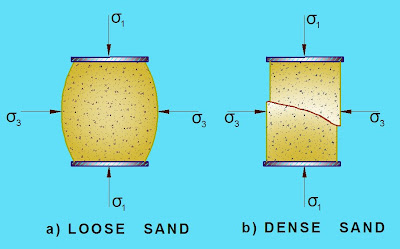Source of Shear strength of Cohesionless Soil
The friction between the particles cohesionless soil like sand and non-plastic silts provides shear strength. In case dense sands the friction as well as interlocking between particles also contributes to these strength.
Brittle Failure
Study on the stress-strain relationship shows that dense sands exhibits a relatively high initial tangent modulus. The stress reaches a maximum value at its peak at comparatively low strain and then decreases rapidly with an increasing strain and eventually becomes more or less constant.,
The dense sand shows initially a volume decrease in a drained test, but as the strain increases, the volume starts increasing.
In the case of dense sand, the specimen shows a clear failure plane and failure is known as brittle failure.
Plastic Failure
The stress-strain curve for a loose sand exhibits a relatively low initial tangent modulus. At large strains, the stress becomes more or less constant. The loose sand shows shows a volume decrease throughout increment of strains.
In the case loose sand, the specimen bulges (swell out) and ultimately fails by sliding simultaneously on numerous planes. The failure is known as plastic failure.

Determination of Failure Envelope
The failure envelope for dense sand can be derived either for the peak stresses or for the ultimate stresses. The value of the angle of shearing resistance (Φ′) for the failure envelope for peak stress is considerably greater than for the ultimate stresses.
In the case of loose sands, as the peak stress and the ultimate stress are identical, there is only one failure envelope. The angle of shearing resistance in very loose state is approximately equal to the angle of repose. It should remember that the angle of repose is the angle at which a heap of dry sand stands without any support. It has been established that air-dry sand gives approximately the same value of Φ as the saturated sand. As it is easier to perform tests on dry sand, tests can be performed on dry sand instead of saturated sand.
If the failure envelope is slightly non-linear, a straight line may be drawn for the given pressure range and the angle of shearing resistance is taken as the slope of this line. The cohesion intercept, if any, is usually neglected.


No comments:
Post a Comment